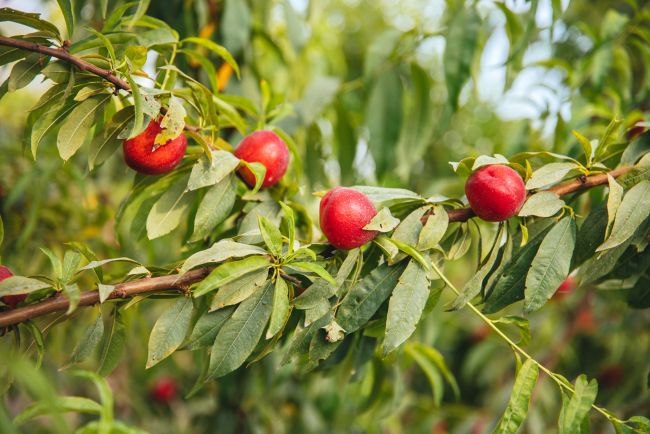Growing Fan-Trained Nectarines

How to Grow a Fan-Trained Nectarine Tree (And Store the Fruit After Harvest)
There’s something incredibly satisfying about growing your own nectarines. Sweet, juicy, and bursting with summer flavour, they’re one of the most rewarding fruits you can grow at home—especially when trained as a fan against a warm wall or fence. Whether you’re working with a small garden, a sunny courtyard, or just want to try something new, fan-training a nectarine is both practical and beautiful.
In this post, we’ll take you through everything you need to know, from selecting the right tree and training it into shape, to pruning for maximum fruit—and finally, how to store and enjoy your harvest.
Why Fan-Train a Nectarine Tree?
In cooler climates like the UK, nectarines need all the sun they can get. Fan-training them against a south- or west-facing wall helps the tree stay warm and productive. Plus:
- You’ll make great use of vertical space—ideal for small gardens.
- The wall reflects heat and helps ripen the fruit.
- You’ll reduce the risk of diseases like peach leaf curl.
- Pruning and picking become much easier with everything in reach.
Getting Started: Choosing and Planting
First up, go for a self-fertile variety so you don’t need a pollination partner. Good options include:
- ‘Lord Napier’ – early, sweet, and reliable.
- ‘Fantasia’ – colourful, great flavour.
- ‘Early Rivers’ – traditional and suited to fan-training.
Pick a young one-year-old whip (a single-stemmed tree) to start with—it’s easier to train from scratch.
When to plant: Between late autumn and early spring, while the tree is dormant.
Where to plant: About 15–30 cm out from the wall or fence. You’ll need to set up a support system—horizontal wires or bamboo canes spaced around 30 cm apart, up to about 2 metres high.
Training Your Tree into a Fan
Year 1: Laying the Foundations
- In spring, cut the main stem down to about 40–50 cm high.
- Let a few side shoots grow.
- Pick the best two to train diagonally left and right at 45 degrees—these are your first “arms.”
Year 2: Building Structure
- Cut those arms back by about one-third in winter to encourage branching.
- Tie in any well-placed new shoots to keep building your fan shape.
- Remove shoots heading directly into or away from the wall.
Ongoing: Shaping and Replacing
As the years go on, keep expanding your fan by training healthy new shoots outward. Space the main arms around 20–30 cm apart, and always make sure sunlight can reach all parts of the tree.
Pruning Nectarines for Fruit
Here’s the golden rule: nectarines fruit on last year’s growth. That means this summer’s shoots will (hopefully) be next summer’s fruiting wood. So we need to strike a balance—removing the old and encouraging the new.
Summer Pruning (July–August)
- Trim back long shoots not needed for structure to 3–5 leaves.
- Remove any crowded or crossing growth.
- Thin the fruit—ideally, leave one fruit every 15–20 cm.
Winter Pruning (January–February)
- Cut back the shoots that carried fruit last year.
- Tie in new shoots in their place to maintain a steady supply of fruiting wood.
- Tidy up the shape and remove anything damaged or misplaced.
Don’t Forget Peach Leaf Curl
This fungal disease is common and damaging—but it’s preventable. From late January to May, cover the tree with a clear plastic cloche or DIY frame to keep the rain off. The spores spread in moisture, so keeping leaves dry is key.
Feeding and Watering Tips
- In early spring, apply a balanced fertiliser like Growmore or blood, fish and bone.
- Once flowers appear, switch to a high-potash liquid feed (like tomato feed) every 2 weeks until harvest.
- Mulch with compost to retain moisture and enrich the soil.
- Keep up the watering during dry spells—especially when fruit is forming.
Picking Your Nectarines
Nectarines ripen from late July through August, depending on variety.
You’ll know they’re ready when:
- The fruit is fully coloured (not green).
- There’s a slight “give” when gently pressed.
- They lift easily from the tree.
- They smell fragrant and sweet.
Harvest gently—nectarines bruise easily—and check the tree every day during peak season. They often ripen at different times.
How to Store Your Nectarines
Fresh nectarines are best eaten straight off the tree, but here’s how to make the most of your harvest:
Short-Term Storage
- Store ripe fruit in the fridge for up to 5 days.
- Bring them to room temperature before eating for the best flavour.
Ripening Off the Tree
- If picked slightly under-ripe, pop them in a paper bag at room temperature.
- They’ll ripen in a couple of days.
Freezing Nectarines
- Slice, remove stones, and freeze flat on a tray.
- Transfer to bags once frozen.
- Great for smoothies, desserts, or baking.
Preserving
- Nectarines make brilliant jam, chutney, or compote.
- You can also dry slices in a low oven or dehydrator for a healthy snack.
Fan-trained nectarines take a little patience, but the payoff is worth it: a tree that fits into your space, looks great, and gives you delicious homegrown fruit. With a bit of seasonal pruning, smart training, and some thoughtful storage, you’ll be enjoying your own nectarines long after the last one is picked.





















